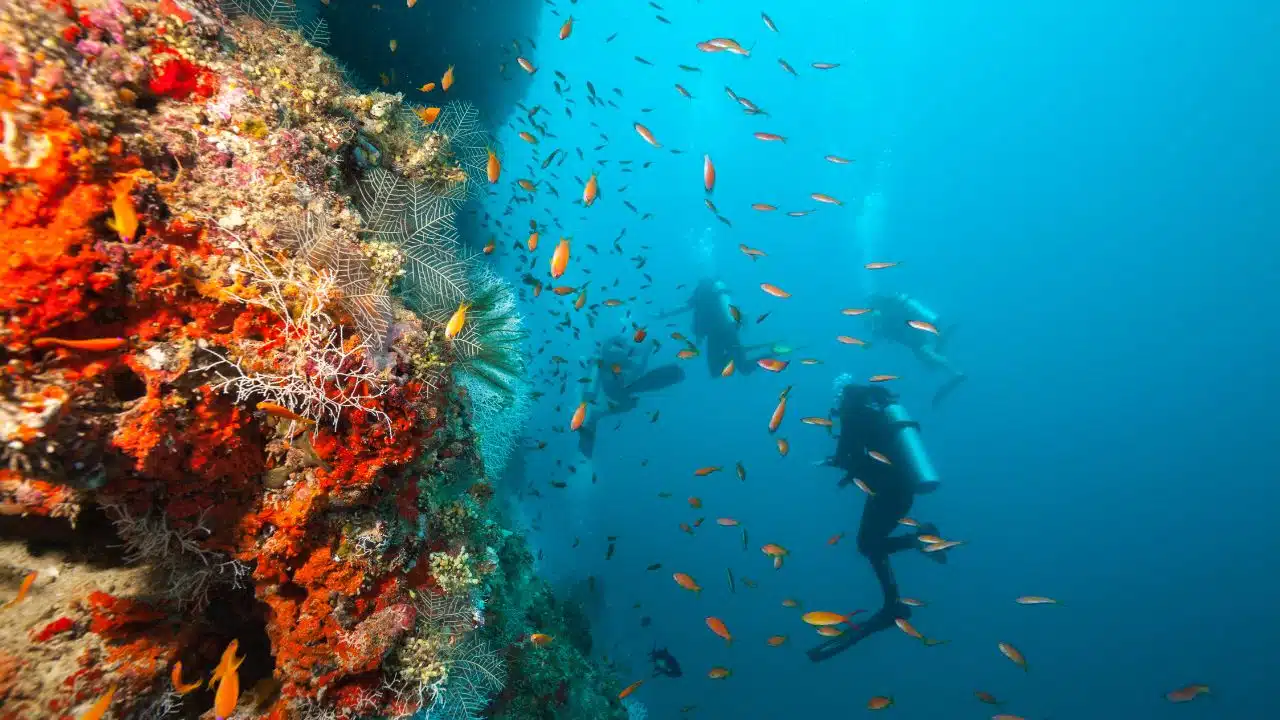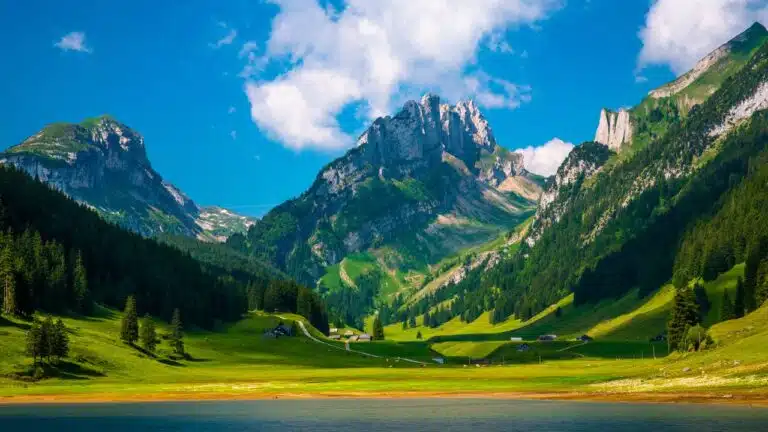The Hawaiian Islands teem with life and beauty above and below sea level. And while Hawaii’s peaks garner plenty of attention for their fiery displays and sun-catching mounts, the ocean depths surrounding Hawaii’s shore promise just as spectacular sights. But while exploring the slopes of slumbering volcanoes is as easy as driving them, scuba diving Hawaii takes a bit more effort. Rest assured, that effort will be far from wasted as you adventure into the deep to discover a tropical paradise that is much different from the one on land but no less vibrant. So, if you’re ready to take the plunge, here’s everything you need to know about scuba diving in Hawaii and what places you can’t miss for an unforgettable trip.
Table of Contents
- Which Hawaii Island Has the Best Diving?
- How Much Does It Cost to Go Scuba Diving in Hawaii?
- When Is the Best Time to Go Scuba Diving in Hawaii?
- Scuba Diving Hawaii? What You Need to Know Before Taking the Plunge
- The 13 Best Places to Scuba Dive in Hawaii
Which Hawaii Island Has the Best Diving?
Anyone familiar with Hawaii’s diving scene will know that no one island can claim the title of best scuba diving spot. Each island has something unique to share, from famous wrecks and artificial reefs to accessible shore dives and animal encounters. It all comes down to personal taste. To find your flavor of Hawaii, you’ll have to determine which island adventures call to you.
Is Scuba Diving Better in Maui or Oahu?
Scuba diving is incredible on both islands, but just like Oahu and Maui themselves, it’s a different experience on each one. Oahu’s wreck diving is unmatched and pairs well with its cosmopolitan energy. However, Maui’s dives offer some of the most extraordinary underwater experiences on all the Hawaiian Islands.
How Much Does It Cost to Go Scuba Diving in Hawaii?
The cost of scuba diving in Hawaii depends on your experience and gear. Experienced divers bringing their own equipment can pay as little as $5 for a tank rental, while boat charters (gear rental included) can cost anywhere from $150 to $300. Meanwhile, Open Water Scuba courses start at around $500.
When Is the Best Time to Go Scuba Diving in Hawaii?
Dive enthusiasts can enjoy scuba diving in Hawaii year-round. With mild ocean temperatures ranging from 77-80°F, Hawaii guarantees a pleasant scuba diving experience no matter when you go. However, many are drawn to Hawaii’s coasts during two particular seasons.
The whale-watching season spans from December 15th to April 15th, and this is a prime time for scuba diving in Hawaii. Though some dive sites are closed thanks to rough surf, winter is a rare chance to see these majestic creatures up close. While scuba divers can’t enter the water within one hundred yards of humpback whales, it’s not uncommon for a curious whale or two to drift closer. But even viewing them from a distance and hearing their enchanting whale songs is worth traveling during this exceptional season.
The other prime time for scuba diving in Hawaii is during the low season, April to June and September to November. The more affordable rates and fewer crowds pair perfectly with the calmer ocean waters and higher visibility for a more enjoyable dive.
Scuba Diving Hawaii? What You Need to Know Before Taking the Plunge
Hawaii’s waters are so inviting we wouldn’t blame you for wanting to dive in immediately. But diving requires more preparation than just donning your gear; you need to know how to use it. And for that, getting your certification is essential.
Now while you don’t technically need certification to go diving in Hawaii, it’ll teach you all the basics of diving and make your open ocean scuba diving experiences safer. Your certification also allows you to go on deeper dives and appreciate more beautiful dive sites around the Hawaiian Islands.
Even if you’ve never dived before, you can get your start from the comfort of your own home with PADI eLearning courses, then local classes. That way, you can save your vacation time for what you’re looking forward to most: open-water dives.
What Gear Do I Need for Scuba Diving in Hawaii?
Of course, even if you already have your certification, diving in Hawaii requires some non-negotiable items you’ll need to bring with you or rent.
- All divers must display a 12 X 12 dive flag wherever a dive occurs.
- Average water temperatures in Hawaii range from 77°F to 80°F, so you’ll need a light wetsuit.
- Dive computers will help you monitor your remaining air.
- A buoyancy control device (BCD) will aid in exploring wreck dives and underwater caves.
- Dive lights are helpful for shedding light on hidden crevices and during night dives.
Because divers heavily rely on their gear, having a save-a-dive kit is a good idea to handle any malfunctions or problems with your equipment. Staying prepared will ensure you stay safe and help you enjoy your scuba diving experiences in Hawaii and worldwide.
The 13 Best Places to Scuba Dive in Hawaii
From heavenly experiences to fun encounters and magical moments, here are thirteen must-see dive spots around the Hawaiian Islands.
Big Island
The Big Island is known as the land of adventure, and its numerous dive sites promise just that. With miles and miles of coastline, the Big Island offers the most scuba diving locations in Hawaii. But don’t worry; in this case, the quality is more than enough to match the quantity.
1. Garden Eel Cove/Manta Heaven
Just like a superhero with a secret identity, Garden Eel Cove goes by two names. By day, Hawaiian garden eels flood the dive site, playing peek-a-boo with divers from the sand. Of course, they’re not the only daytime creatures you may encounter; spinner dolphins occasionally make an appearance.
But when night falls, the secret identity of Garden Eel Cove is revealed: Manta Heaven. Lights on the ocean floor draw in scores of plankton, which in turn attract manta rays to the area. For the manta ray night dive, guests need only settle into the sand and enjoy the show as manta rays glide and dance through the water. It’s a performance not to be missed on a scuba diving trip to the Big Island.
2. Suck ‘Em Up Lava Tube
Unique doesn’t begin to encompass this scuba dive site near Kona on the Big Island. Featuring underwater lava caves, scuba divers passing through are greeted with dappled sunlight and various marine life hiding in the shadows. It’s common to spot whitetip reef sharks taking it easy or pufferfish lurking in the crevices as you explore the caverns and appreciate the coral.
The cavern has two entrances, a larger opening on the south end and a smaller one on the north end, which creates a dynamic current. So, if you time it right, you can get sucked up with the current and spat back near shore for a last bit of fun on your cavern dive.
3. Black Water/Pelagic Magic Dive
Nighttime is a magical time for Hawaii scuba diving on the Big Island. The black water dives, or as these night dives are often called, Pelagic Magic Dives, are an enchanting event you can see on film but are best experienced up close and personal.
Traveling past Kona reefs, divers tether themselves to a boat before venturing into the black waters. Up from the depths drift pelagic creatures of eerie beauty, like larval octopi and crabs, and comb jelly. Watching these shimmering creatures drift by in the dark will feel like a dream, but the experience is a hundred percent real.
4. Crescent Beach
One of the best shore diving sites on the Big Island, Crescent Beach is a popular local hangout for a good reason, or several. Those reasons include tiger sharks, Hawaiian green sea turtles, spotted eagle rays, spinner dolphins, and all kinds of other reef fish you could hope to see on a scuba diving adventure in Hawaii.
The sheer diversity of large marine life at Crescent Beach is astounding. Add on its colorful coral backdrop, and it’s little wonder this site draws in its fair share of eager scuba divers hoping for an up-close encounter with the tiger sharks that frequent the bay or the gentle honu drifting by.
Maui
The best shore dives and unique day trips await on the Valley Isle. From rock craters teeming with life to underwater cathedrals full of magic, Maui’s scuba diving experiences are unrivaled.
5. Makena Landing
If Makena Landing were a person, the multitude of names would be enough to raise eyebrows. But whether you call the dive site here Five Graves or Five Caves, Turtle Town or Turtle Arches, it won’t change the magic behind it. Located just off Nahuna Point, the area is famous for its underwater sea arches and turtles, both of which are to thank for the variety of titles.
The bright coral is sure to catch your eye, along with plenty of other marine creatures like butterfly fish, white tip reef sharks, octopus, and, if you’re lucky, manta rays. Thankfully, you won’t need much luck to spot sea turtles. As a nesting ground for the beautiful honu, your chance to swim with sea turtles awaits.
6. Lanai Cathedrals
Divers looking for a heavenly experience need to look no further than the Lanai Cathedrals. Lava once flowed through these giant underwater caverns, creating breathtaking volcanic formations and stunning backdrops you can explore today. But the most notable feature is owed to collapsed lava tubes, which knocked out parts of the caverns’ ceilings. As a result, the cathedrals now sport open ceilings that allow light to shine in through the water, much like the light through a church’s stained glass window, creating that heavenly atmosphere.
Of course, it’s not just beloved by divers. Marine life also thrives here, including sharks, dolphins, turtles, and occasionally whales. The two cathedrals are often treated as two different dive sites, so you’ll want to make time for both on your trip. However, the First Cathedral is highly recommended if you can only do one.
7. Molokini Crater
This remote scuba diving adventure is a one-of-a-kind Hawaii escapade. As one of only three partially submerged volcanic calderas in the world, there aren’t many places you can go to recreate the experience you’ll have here. Located forty minutes off the coast of Maui, the rock crater offers 150 feet of visibility, all the better to take in the breathtaking sights and underwater world near Hawaii’s only island marine sanctuary.
Though the crater wall extends 300 feet down, most dives won’t go below 80. But you’ll still see plenty at that depth, including black and whitetip reef sharks, dolphins, manta rays, and other fish. Between the pristine reefs, crystal-clear waters, and stunning wildlife, you’re in for a show no matter when you go. But, if you time your trip just right, you can experience the enchantment of sharing the waters with their most majestic occupant, humpback whales.
Oahu
Featuring so much history and culture on land, it seems only fitting that the waters surrounding Oahu would sport much of the same. Scuba diving off the shores of the Gathering Place reveals some of the most beautiful wrecks in the US along the ocean floors.
8. YO-257
The YO-257 wreck is among the most famous wreck dives in the US. Sunk in 1989 by Atlantis Submarines Hawaii as a sightseeing attraction for visitors, it’s slowly become a massive artificial reef bursting with life. Cutouts on the ship allow divers to swim through the wreckage and spy octocoral hanging from the ceiling like chandeliers and spawning along the ship’s walls.
But divers aren’t the only frequent visitors the YO-257 sees. Observant divers often catch green sea turtles swimming among the wreckage and manta rays performing flybys. But perhaps the most startling sight of all will be the occasional submarine visiting this stunning attraction.
9. Sea Tiger
Originally a Chinese trading vessel, the Sea Tiger sailed to Hawaii in the 1990s, where it was confiscated and bought by Voyager Submarines. The company sank the ship in 1999 off Oahu’s south shore, where it sits below the water’s surface, frozen in time.
The vessel has decayed very little, while the marine life around it has thrived, leading to incredible sights stretching along the 150-foot ship. Divers can explore the vessel’s interior through the bridge and cargo holds and will likely run into some interesting faces in the wreck, including eagle rays, sea turtles, and reef sharks.
10. Navy Tug
Officially known as the USS Nashua, you’ll likely get blank stares if you call it anything other than the Navy Tug. Sunk in 2012, the wreck is barely a decade old but is a popular spot to scuba dive in Hawaii thanks to its shallow depth at 65ft and the ocean critters that have already made it their home, from octopuses and eels to puffer fish and reef sharks.
It’s fitting that this artificial reef made from a navy ship is now a navy training site too. You may even spot equipment in lock boxes on the ocean floor. But, then again, your eyes might be too busy taking in the incredible sights that surround this striking wreck.
Kauai
Kauai’s untamed wilds extend from its dense jungles to its isolated shores and out into the Pacific to serve up an unequal scuba diving adventure you have to experience for yourself.
11. Vertical Awareness
The land of the Forbidden Isle, Niihau, may be off limits, but its waters are ripe for exploration, and thank the deep for that. As the name suggests, the underwater landscape features impressive vertical features, like a sheer rock wall that drops over 150 feet. Rocky formations and colorful fish abound, but what makes the two-hour boat ride more than worth it is the opportunity to see Hawaii’s only endemic sea mammal.
Hawaiian monk seals frolic around Vertical Awareness, posing for photos and chasing each other through the crystal clear waters. The astounding visibility makes this one of the best scuba diving sites in Hawaii to snap a picture of these creatures in their element.
12. Sheraton Caverns
Divers can’t say they’ve been Kauai diving without a trip to Sheraton Caverns. A few hundred yards separate it from the Sheraton Kauai Resort, but what the name lacks in creativity, the site more than makes up for in wonders. Collapsed lava tubes create an intricate underwater playground, with sun-dappled caverns hosting schools of fish and Hawaii’s other famous resident: sea turtles. So if you’re looking to get your fix for the gorgeous honu in Hawaii, you can’t skip scuba diving at Sheraton Caverns.
13. Koloa Landing
Kauai doesn’t have a lot of shore dives. In fact, it only has one. But, when that one is Koloa Landing, you quickly realize one is all you need. Located on Kauai’s southern shore, the protected bay features calm waves year-round and easy-to-navigate waters. But the abundant marine life makes this a favorite for scuba divers and snorkeling enthusiasts. From resting honu to curious monk seals and even whale songs in the winter, Koloa Landing delights visitors in every season, making it a must-dive spot when visiting the Garden Isle.



